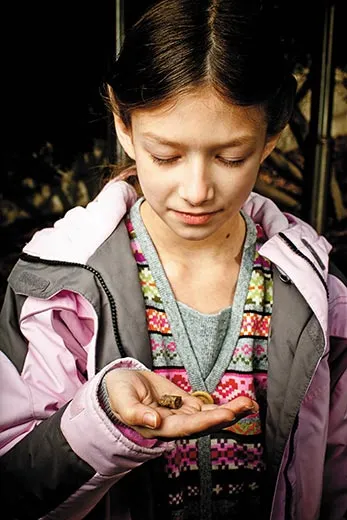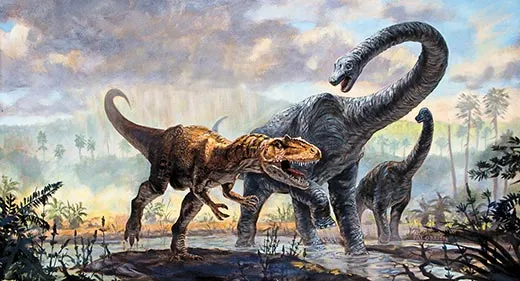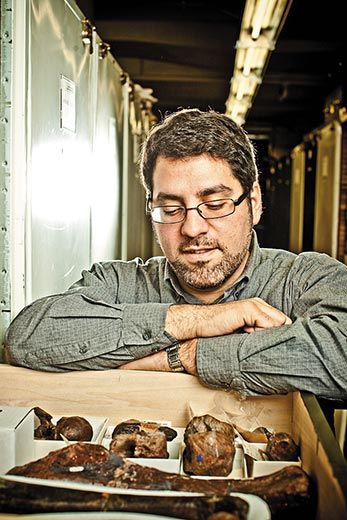A Dinosaur Graveyard in the Smithsonian’s Backyard
At a new dinosaur park in Maryland, children and paleontologists alike have found fossils for a new Smithsonian exhibit
/https://tf-cmsv2-smithsonianmag-media.s3.amazonaws.com/filer/ATM-Dinosaur-Astrodon-johnstoni-631.jpg)
Last november, at the recently opened Dinosaur Park south of Laurel, Maryland, the Block family went searching for fossils. Karin Block, the mother, asked the park’s resident paleontologist, Peter Kranz, for tips. He suggested looking for porous, spongy-looking stones.
No sooner did he say that than 9-year-old Gabrielle came across a curious thumbnail-sized object. She showed it to Kranz, who immediately pegged it as a 110-million-year-old bone, a vertebra from the tail of a small carnivorous dinosaur, possibly a raptor.
For the time being, the bone resides in a plastic bag that Kranz carries with him. But it will eventually make its way to the back halls of the Smithsonian National Museum of Natural History. “Kids are really good at fossil-hunting because they don’t have preconceptions of what things are supposed to look like,” says Matthew Carrano, the museum’s curator of dinosaurs.
In the paleontology department’s warren-like offices and labs are drawers teeming with bone fragments, teeth and other fossils—many found in nearby Maryland. Some of the specimens (but not Gabrielle Block’s) will be featured in a museum exhibit opening in February, “Dinosaurs in Our Backyard.”
Dinosaurs thrived in what is now Maryland from the Late Triassic period to the Cretaceous, 228 million to 65 million years ago. The primordial landscape—tropical lowlands and a shallow sea—created ideal conditions for the preservation of animal and plant remains, which were buried beneath layers of clay and silt deposited by water flowing into the low-lying terrain.
Today Maryland is one of the richest fossil-hunting sites east of the Mississippi. The earliest recorded discovery was two teeth, found in 1858 near Beltsville by an agricultural chemist, Philip Tyson. He gave the fossils to a dentist named Christopher Johnston to investigate. After cutting into one, Johnston observed that the cross section resembled a star. He named the dinosaur Astrodon, or “star tooth.” Seven years later, the paleontologist Joseph Leidy would formally record the species as Astrodon johnstoni—a large, long-necked, plant-eating sauropod, like the Apatosaurus.
In the following decades, a veritable who’s who of paleontologists journeyed to Maryland, including O. C. Marsh of Yale University. His assistant, John Bell Hatcher, described his work in Muirkirk, Maryland, in an 1888 letter to Marsh: “The past week I have taken out about 200 teeth....In collecting what I have, I don’t think I have moved over a bushel basket-full of dirt.”
The most spectacular discovery was made in 1991. Arnold Norden and his two children visited the Cherokee Sanford clay pit near Muirkirk. After seeing what looked like a bone, Norden called the Smithsonian, which sent three researchers from the Natural History Museum’s paleobiology department. They uncovered the largest dinosaur bone found in the northeastern United States: a three-foot-long, 90-pound section of an Astrodon’s thigh.
Carrano is not anticipating many more spectacular finds. “We tend to get small, isolated bones,” he says—enough to help piece together the picture of local dinosaur species. Carrano attributes the shortage of large bones to the numerous ponds once in the area. The pools attracted predators and scavengers, which disposed of animals and their remains, and, what’s more, pond bacteria hastened bone decay.
Meanwhile, Gabrielle Block’s younger sister, Rachael, 7, is undeterred. She wants to return to the publically run dinosaur park and one-up her sibling: she’s determined to find a “complete dinosaur.”


